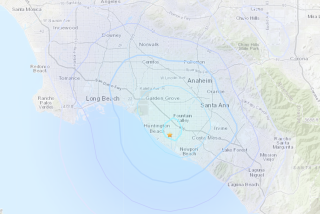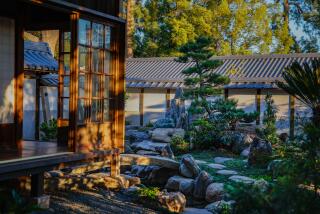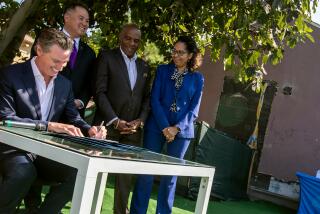Old Values Survive at Newland
The Newland House Museum, Huntington Beach’s oldest home, sits off busy Beach Boulevard on the edge of a strip mall complete with fast-food joints, a bank and a supermarket.
But visitors who step inside the 107-year-old Victorian farmhouse are transported to a simpler time, when Beach Boulevard was a two-lane cow path and the land surrounding the house held lima beans, chile peppers, celery and sugar beets.
“Agriculture was the main industry,” said docent Jerry Person. “Now it’s traffic.”
Person has been leading tours through the restored home for 23 years, telling tales of Huntington Beach pioneers William and Mary Newland and their 10 children.
The Newlands, originally from Illinois, moved to California to escape the brutal Midwestern winters. First they moved to Morro Bay, but fog that aggravated Mary Newland’s arthritis drove them south, where they eventually settled in what is now Huntington Beach.
The family bought 500 acres of mesas and marshes for between $12 and $50 an acre and built a home for $1,485 in 1898. The land is the site of an ancient Indian village, where cog stones and other archeological items have been unearthed.
In addition to farming, William Newland was heavily involved in area commerce, sitting on the boards of Security Pacific Bank, the Huntington Beach News and other businesses.
The couple also were involved in the city’s nascent civic life, both serving on local school boards and in other community capacities until William Newland’s death in 1933, and Mary Newland’s passing in 1952.
After their deaths, the land was leased to an oil company and the house rented to its employees until 1972, when the Newland family donated the house to the city.
The Huntington Beach Historical Society spent four years restoring the home to its early 20th century appearance. The house, encircled by wrought iron, is on the National Register of Historic Places.
Inside is an array of original and period pieces, including hand-stitched quilts atop the daughters’ beds, a hand-cranked Victrola phonograph in the parlor and a small Singer sewing machine in the sun-filled octagonal turret that was Mary Newland’s sewing room. Photographs of the family and early life in Huntington Beach have been placed throughout the house.
Thousands tour the home every year, including elementary school students on field trips, scouts, senior citizens and college students doing research.
Person’s pithy comments accompany visitors throughout the tour. When he dryly points out the “downstairs bathroom,” he points to a white porcelain chamber pot beneath the guestroom bed. Noting that the children had one small drawerful of toys, he says, “If you tried that today, that would be considered child abuse.”
On Saturday, a troop of Cub Scouts toured the house because they needed to visit a historic place to earn a patch.
“It’s kind of hard to do in Orange County,” said Greg Hill, the father of 7-year-old Spencer.
He told the first-grader, “You’re going to learn what it was like to live 100 years ago.”
The boy’s eyes widened and jaw dropped. “Wowww,” he said.
The Newland House Museum, 19820 Beach Blvd. near East Adams Avenue, is open for docent-led tours from noon to 4 p.m. Saturdays and Sundays, except holidays. A $2 donation is requested. Information: (714) 962-5777.
More to Read
Sign up for Essential California
The most important California stories and recommendations in your inbox every morning.
You may occasionally receive promotional content from the Los Angeles Times.










